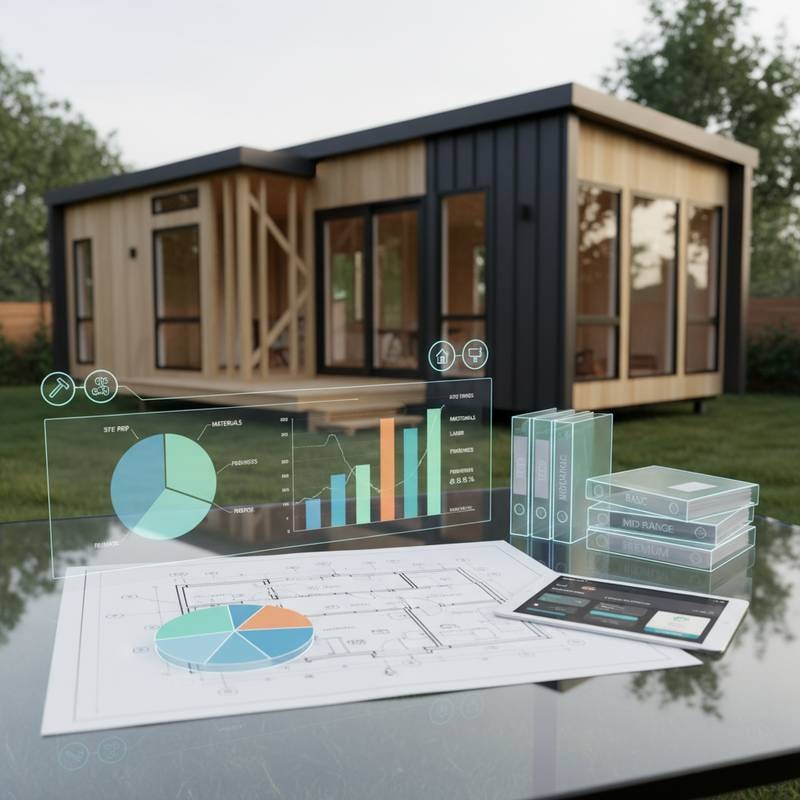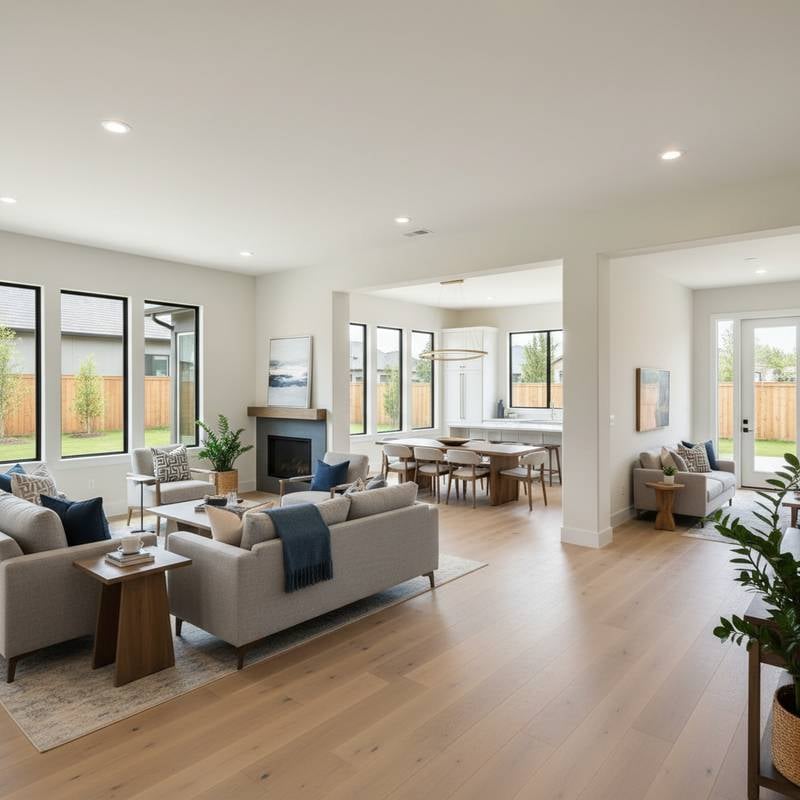2025 ADU Costs: Plan Your Granny Flat Budget Wisely
Accessory dwelling units, known as granny flats or backyard cottages, expand living options for homeowners. These structures serve as rental properties, family suites, or home offices. Grasping the full cost spectrum enables informed decisions from the outset.
This resource outlines expense drivers, categorizes budgets effectively, and provides strategies to optimize spending. Homeowners gain tools to align projects with financial realities while achieving functional designs.
Core Components of ADU Budgeting
ADU expenses fluctuate based on scale, style, and site specifics. Budgets divide into three primary categories: site preparation, structural elements, and interior finishes. This framework clarifies allocation and highlights opportunities for efficiency.
Site preparation handles groundwork like grading and utility extensions. Structural elements encompass framing, roofing, and exteriors. Finishes cover internal features such as flooring and fixtures. Each category demands targeted planning to control overall outlay.
ADU Types and Their Price Implications
Project costs align with the chosen ADU configuration. Select the type that matches your property and objectives to minimize unnecessary expenditures.
- Garage Conversion: Leverages existing shells, focusing funds on insulation, plumbing, and partitions. Typical range: $50,000 to $150,000 for 400 square feet.
- Attached Unit: Integrates with the primary residence, sharing walls and utilities. Expect $150,000 to $250,000, including minor structural adjustments.
- Detached Structure: Requires independent foundations and connections. Budget $200,000 to $400,000 for standalone builds.
- Above-Garage Addition: Elevates space over parking areas, involving reinforced framing. Costs often hit $250,000 to $350,000 due to engineering needs.
Key Influences on Total Expenses
Project uniqueness stems from multiple variables. Address these early to refine estimates and avoid surprises.
-
Footprint and Configuration: Expand square footage incrementally; costs per square foot drop beyond 600 feet. Favor linear layouts over irregular ones to cut framing by 15 to 20 percent.
-
Architectural Details: Vaulted ceilings or multi-level designs elevate labor by 10 to 25 percent. Standard gable roofs streamline assembly compared to complex hips.
-
Regulatory Hurdles: Permits average $5,000 to $15,000; impact fees vary by municipality. Consult zoning offices for setback rules and code updates before sketching plans.
-
Infrastructure Extensions: Proximity to main utilities reduces trenching costs; long runs add $10,000 or more. Evaluate sewer access and power lines during site surveys.
-
Exterior Selections: Opt for fiber cement over vinyl for 30-year durability, though initial outlay rises 20 percent. Metal roofs outperform asphalt in longevity, justifying premium pricing.
-
Workforce Expenses: Regional rates differ; urban zones command 30 percent higher fees. Secure bids from three licensed contractors to benchmark fair pricing.
-
Core Interiors: Kitchens and baths drive 25 percent of budgets. Select quartz counters over granite to save $3,000 to $5,000 without compromising utility.
Detailed Expense Allocation
Dissect costs by phase for precise forecasting. Allocate funds proportionally: 20 percent to site work, 50 percent to structure, 30 percent to finishes.
Foundation and Skeleton: Slabs suit flat lots at $8 to $12 per square foot; piers handle slopes at $10 to $15. Engineered lumber frames accelerate builds while meeting seismic standards.
Roofing and Cladding: Asphalt options cost $4 to $6 per square foot installed; metal variants reach $10 to $14 for superior weatherproofing. Stucco siding blends aesthetics and resilience in varied climates.
Openings for Light and Access: Double-pane windows average $400 to $800 each; low-E coatings cut energy bills by 15 percent annually. Bi-fold doors enhance flow in compact kitchens.
Systems Integration: Plumbing setups for full baths run $10,000 to $20,000; electrical panels with GFCI outlets ensure compliance. Hire certified specialists to pass inspections on first try.
Surface Treatments: Laminate counters and LVT flooring total $5 to $8 per square foot. Apply semi-gloss paints in shades like soft taupe for easy upkeep and broad appeal.
Equipment and Hardware: Stackable washers and induction ranges fit tight budgets at $1,500 to $3,000. Prioritize models with smart controls for efficiency in small footprints.
Geographic Cost Differences
Location dictates 40 percent of variance. High-density cities impose elevated labor and fees; rural sites offset with transport surcharges. Adapt foundations for expansive soils in the Southwest or heavy snow loads in the Northeast. Insulation R-values must comply with local energy codes to qualify for rebates.
Modular Versus Traditional Construction
Modular ADUs assemble in weeks, capping costs at $150 to $250 per square foot. Traditional methods allow bespoke integrations but extend timelines to six months and introduce 10 to 15 percent overruns.
- Modular Benefits: Factory precision minimizes errors; fixed bids shield against inflation.
- Modular Limitations: Standard modules restrict expansions; site cranes add $5,000 to $10,000.
- Traditional Strengths: Seamless matches to home styles; phased payments align with progress.
- Traditional Challenges: Weather halts work; scope creep demands strict change controls.
Practical Ways to Trim Expenses
Target efficiencies without eroding quality. These tactics can reduce totals by 20 to 30 percent.
-
Streamline Geometry: Adopt open-plan interiors with fewer partitions to lower drywall and electrical runs.
-
Balance Quality Levels: Source bamboo flooring at $4 per square foot for eco-friendly durability over pricier hardwoods.
-
Scale Appropriately: Cap at 800 square feet; this threshold maximizes utility while containing foundation costs under $15,000.
-
Leverage On-Site Resources: Connect to existing septic if viable, avoiding $20,000 in new installations.
-
Handle Select Tasks: Install shelving or mulch gardens personally, reserving pros for load-bearing elements.
Funding Approaches
Secure capital through equity taps or specialized loans. HELOCs offer flexible draws at 7 to 9 percent rates; municipal grants aid income-qualified builds. Build in 10 to 15 percent buffers for variances like utility upgrades. Track expenditures monthly to stay on course.
ADU Versus Alternative Upgrades
ADUs demand more than kitchen refreshes ($30,000 average) yet deliver less than primary additions ($300,000 plus). Rental yields of $1,500 monthly recoup investments in 10 to 15 years, surpassing many renovations in ROI.
Frequently Asked Questions on Pricing
How does one calculate project totals? Multiply square footage by $200 to $400 baselines, then layer in site-specific add-ons. Engage architects for scaled drawings and cost models.
Will an ADU boost resale value? Absolutely; it contributes 70 to 90 percent of build costs to appraisals, plus income potential.
Is owner-building feasible? Partial involvement works for non-structural phases; codes mandate pros for wiring and sanitation to avert liabilities.
What ongoing expenses arise? Budget $1,000 yearly for upkeep, including gutter clears and filter changes, akin to a studio apartment.
Aligning Aesthetics with Affordability
Harmonize the ADU with primary architecture for curb appeal. Pair board-and-batten siding on craftsman homes or sleek metal accents on modern facades. Select roof hues like charcoal gray to complement landscaping. Lighter exteriors in arid zones resist fading, easing repaint cycles every seven years.
Realizing Lasting Advantages
ADUs furnish adaptable spaces that evolve with life stages. Rental streams or guest quarters enhance financial security. Sustainable builds with solar-ready wiring and low-flow fixtures yield savings exceeding $500 annually. Invest thoughtfully to secure enduring utility and equity growth.
Steps to Launch Your Project
Define needs like occupancy or revenue goals first. Assemble a budget spreadsheet covering all categories plus reserves. Consult local experts for tailored advice, ensuring the granny flat enriches your property sustainably.











